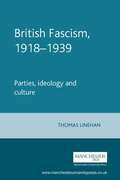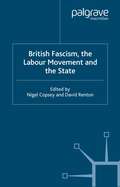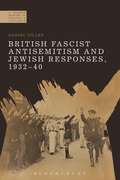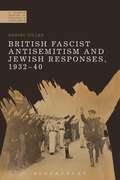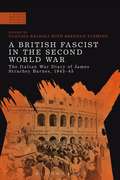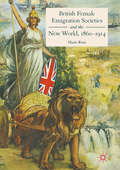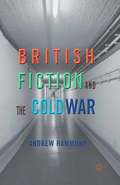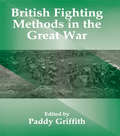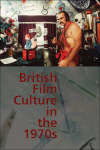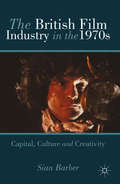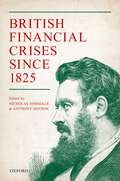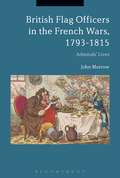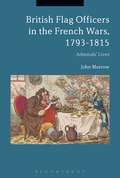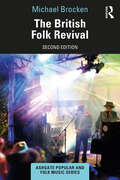- Table View
- List View
British Fascism, 1918–1939: Parties, ideology and culture (Manchester Studies in Modern History)
by Thomas LinehanA major new and balanced study of British Facism which surveys the development of British fascism between 1918 and 1939. Provides an accessible guide to the essential features of British fascism in the interwar period. Considers a previously under-researched area of British fascism, namely fascism and culture. Explores the various definitions of fascism, before moving on to analyse the origins of British fascism, the fascist parties and groups, fascism and culture, the membership, and British fascist antisemitism.
British Fascism, the Labour Movement and the State
by N. Copsey D. RentonConsiderable attention has been paid to far-right parties and their leaders, Oswald Mosley, A. K. Chesterton, John Tyndall and Nick Griffin. But what about the forces that have been organised in opposition to fascism in Britain? British Fascism, the Labour Movement and the State brings together the leading historians in the field to trace the history of labour movement responses to the far-right from the 1920s to the present. It examines the rise and fall of different fascist groups in terms of wider social processes, above all the hostility of the labour movement, left-wing parties, the women's movement and the trade unions.
British Fascist Antisemitism and Jewish Responses, 1932-40 (A Modern History of Politics and Violence)
by Daniel TillesThis book explores the use of antisemitism by Britain's interwar fascists and the ways in which the country's Jews reacted to this, examining the two alongside one another for the first time and locating both within the broader context of contemporary events in Europe.Daniel Tilles challenges existing conceptions of the antisemitism of Britain's foremost fascist organisation, the British Union of Fascists. He demonstrates that it was a far more central aspect of the party's thought than has previously been assumed. This, in turn, will be shown to be characteristic of the wider relationship between interwar European fascism and antisemitism, a thus far relatively neglected issue in the burgeoning field of fascist studies. Tilles also argues that the BUF's leader, Sir Oswald Mosley, far from being a reluctant convert to the anti-Jewish cause, or simply a cynical exploiter of it, as much of the existing scholarship suggests, was aware of the role antisemitism would play in his fascist doctrine from the start and remained in control of its subsequent development. These findings are used to support the notion that, contrary to prevailing perceptions, Jewish opposition to the BUF played no part in provoking the fascists' adoption of antisemitism. Britain's Jews did, nevertheless, play a significant role in shaping British fascism's path of development, and the wide-ranging and effective anti-fascist activity they pursued represents an important alternative narrative to the dominant image of Jews as mere victims of fascism.
British Fascist Antisemitism and Jewish Responses, 1932-40 (A Modern History of Politics and Violence)
by Daniel TillesThis book explores the use of antisemitism by Britain's interwar fascists and the ways in which the country's Jews reacted to this, examining the two alongside one another for the first time and locating both within the broader context of contemporary events in Europe.Daniel Tilles challenges existing conceptions of the antisemitism of Britain's foremost fascist organisation, the British Union of Fascists. He demonstrates that it was a far more central aspect of the party's thought than has previously been assumed. This, in turn, will be shown to be characteristic of the wider relationship between interwar European fascism and antisemitism, a thus far relatively neglected issue in the burgeoning field of fascist studies. Tilles also argues that the BUF's leader, Sir Oswald Mosley, far from being a reluctant convert to the anti-Jewish cause, or simply a cynical exploiter of it, as much of the existing scholarship suggests, was aware of the role antisemitism would play in his fascist doctrine from the start and remained in control of its subsequent development. These findings are used to support the notion that, contrary to prevailing perceptions, Jewish opposition to the BUF played no part in provoking the fascists' adoption of antisemitism. Britain's Jews did, nevertheless, play a significant role in shaping British fascism's path of development, and the wide-ranging and effective anti-fascist activity they pursued represents an important alternative narrative to the dominant image of Jews as mere victims of fascism.
A British Fascist in the Second World War: The Italian War Diary of James Strachey Barnes, 1943-45 (A Modern History of Politics and Violence)
by Claudia Baldoli Brendan FlemingA British Fascist in the Second World War presents the edited diary of the British fascist Italophile, James Strachey Barnes. Previously unpublished, the diary is a significant source for all students of the Second World War and the history of European and British fascism.The diary covers the period from the fall of Mussolini in 1943 to the end of the war in 1945, two years in which British fascist Major James Strachey Barnes lived in Italy as a 'traitor'. Like William Joyce in Germany, he was involved in propaganda activity directed at Britain, the country of which he was formally a citizen. Brought up by upper-class English grandparents who had retired to Tuscany, he chose Italy as his own country and, in 1940, applied for Italian citizenship. By then, Barnes had become a well-known fascist writer. His diary is an extraordinary source written during the dramatic events of the Italian campaign. It reveals how events in Italy gradually affected his ideas about fascism, Italy, civilisation and religion. It tells much about Italian society under the strain of war and Allied bombing, and about the behaviour of both prominent fascist leaders and ordinary Italians. The diary also contains fascinating glimpses of Barnes's relationship with Ezra Pound, with Barnes attaching great significance to their discussion of economic issues in particular.With a scholarly introduction and an extensive bibliography and sources section included, this edited diary is an invaluable resource for anyone interested in learning more about the ideological complexities of the Second World War and fascism in 20th-century Europe.
A British Fascist in the Second World War: The Italian War Diary of James Strachey Barnes, 1943-45 (A Modern History of Politics and Violence)
by Claudia Baldoli Brendan FlemingA British Fascist in the Second World War presents the edited diary of the British fascist Italophile, James Strachey Barnes. Previously unpublished, the diary is a significant source for all students of the Second World War and the history of European and British fascism.The diary covers the period from the fall of Mussolini in 1943 to the end of the war in 1945, two years in which British fascist Major James Strachey Barnes lived in Italy as a 'traitor'. Like William Joyce in Germany, he was involved in propaganda activity directed at Britain, the country of which he was formally a citizen. Brought up by upper-class English grandparents who had retired to Tuscany, he chose Italy as his own country and, in 1940, applied for Italian citizenship. By then, Barnes had become a well-known fascist writer. His diary is an extraordinary source written during the dramatic events of the Italian campaign. It reveals how events in Italy gradually affected his ideas about fascism, Italy, civilisation and religion. It tells much about Italian society under the strain of war and Allied bombing, and about the behaviour of both prominent fascist leaders and ordinary Italians. The diary also contains fascinating glimpses of Barnes's relationship with Ezra Pound, with Barnes attaching great significance to their discussion of economic issues in particular.With a scholarly introduction and an extensive bibliography and sources section included, this edited diary is an invaluable resource for anyone interested in learning more about the ideological complexities of the Second World War and fascism in 20th-century Europe.
British Female Emigration Societies and the New World, 1860-1914
by Marie RuizThis book focuses on the departure of Britain’s 'surplus' women to Australia and New Zealand organised by Victorian British female emigration societies. Starting with an analysis of the surplus of women question, it then explores the philanthropic nature of the organisations (the Female Middle Class Emigration Society, the Women’s Emigration Society, the British Women’s Emigration Association, and the Church Emigration Society). The study of the strict selection of distressed gentlewomen emigrants is followed by an analysis of their marketing value, and an appraisal of women’s imperialism. Finally, this work shows that the female emigrants under study partook in the consolidation of the colonial middle-class.
British Female Emigration Societies and the New World, 1860-1914
by Marie RuizThis book focuses on the departure of Britain’s 'surplus' women to Australia and New Zealand organised by Victorian British female emigration societies. Starting with an analysis of the surplus of women question, it then explores the philanthropic nature of the organisations (the Female Middle Class Emigration Society, the Women’s Emigration Society, the British Women’s Emigration Association, and the Church Emigration Society). The study of the strict selection of distressed gentlewomen emigrants is followed by an analysis of their marketing value, and an appraisal of women’s imperialism. Finally, this work shows that the female emigrants under study partook in the consolidation of the colonial middle-class.
British Fiction and the Cold War
by A. HammondThis book offers a unique analysis of the wide-ranging responses of British novelists to the East-West conflict. Hammond analyses the treatment of such geopolitical currents as communism, nuclearism, clandestinity, decolonisation and US superpowerdom, and explores the literary forms which writers developed to capture the complexities of the age.
British Fighting Methods in the Great War
by Paddy GriffithThis collection points out the very real and substantial evolution of tactics that went on in response to new warfare and how this had a real effect on the positive performance of the British Army from 1916 onwards.
British Fighting Methods in the Great War
by Paddy GriffithThis collection points out the very real and substantial evolution of tactics that went on in response to new warfare and how this had a real effect on the positive performance of the British Army from 1916 onwards.
British Film Culture in the 1970s: The Boundaries of Pleasure
by Sue Harper Justin SmithThis volume draws a map of British film culture in the 1970s and provides a wide-ranging history of the period.
British Film Design: A History (Cinema and Society)
by Laurie N. EdeBritish Film Design' is about the things that you see when you close your eyes and think of British cinema. It is about Dr No's hideaway, the ballet of The Red Shoes, the buffet of Brief Encounter, Vera Drake's parlour, Hogwarts School … and a thousand other visions of British films. Moreover, 'British Film Design' is about the people who have created those visions.The physical environments of films are made by Production Designers, otherwise known as Art Directors. Their efforts have tended to go unnoticed by cinema audiences. 'British Film Design' addresses thistendency by offering the first comprehensive historical survey of British art direction.The book takes a chronological journey through British film design, starting with the efforts of the film'primitives' of the silent era and ending with the modern-day purveyors of part built/part computer-generated 'blended design'. Certain themes recur en route. These include British cinema's obsession with realism (its 'Lumieres Complex'); the Production Designer's continual struggle for recognition; influence from European artists; and the benefits -and perils -of American finance.More than anything, British Film Design expresses the joy of looking at films from inside out; seeingbeyond the stars to recognise sets as silent players in the action.
The British Film Industry in 25 Careers: The Mavericks, Visionaries and Outsiders Who Shaped British Cinema
by Geoffrey MacnabThe British Film Industry in 25 Careers tells the history of the British film industry from an unusual perspective - that of various mavericks, visionaries and outsiders who, often against considerable odds, have become successful producers, distributors, writers, directors, editors, props masters, publicists, special effects technicians, talent scouts, stars and, sometimes, even moguls. Some, such as Richard Attenborough and David Puttnam, are well-known names. Others, such as the screenwriter and editor Alma Reville, also known as Mrs Alfred Hitchcock; Constance Smith, the 'lost star' of British cinema, or the producer Betty Box and her director sister Muriel, are far less well known. What they all have in common, though, is that they found their own pathways into the British film business, overcoming barriers of nationality, race, class and gender to do so.Counterpointing the essays on historical figures are interviews with contemporaries including the director Amma Asante, the writer and filmmaker Julian Fellowes, artist and director Isaac Julien, novelist and screenwriter Hanif Kureishi, and media entrepreneur Efe Cakarel, founder of the online film platform MUBI, who've come into today's industry, adjusting to an era in which production and releasing models are changing – and in which films are distributed digitally as well as theatrically.
The British Film Industry in 25 Careers: The Mavericks, Visionaries and Outsiders Who Shaped British Cinema
by Geoffrey MacnabThe British Film Industry in 25 Careers tells the history of the British film industry from an unusual perspective - that of various mavericks, visionaries and outsiders who, often against considerable odds, have become successful producers, distributors, writers, directors, editors, props masters, publicists, special effects technicians, talent scouts, stars and, sometimes, even moguls. Some, such as Richard Attenborough and David Puttnam, are well-known names. Others, such as the screenwriter and editor Alma Reville, also known as Mrs Alfred Hitchcock; Constance Smith, the 'lost star' of British cinema, or the producer Betty Box and her director sister Muriel, are far less well known. What they all have in common, though, is that they found their own pathways into the British film business, overcoming barriers of nationality, race, class and gender to do so.Counterpointing the essays on historical figures are interviews with contemporaries including the director Amma Asante, the writer and filmmaker Julian Fellowes, artist and director Isaac Julien, novelist and screenwriter Hanif Kureishi, and media entrepreneur Efe Cakarel, founder of the online film platform MUBI, who've come into today's industry, adjusting to an era in which production and releasing models are changing – and in which films are distributed digitally as well as theatrically.
The British Film Industry in the 1970s: Capital, Culture and Creativity
by S. BarberIs there more to 1970s British cinema than sex, horror and James Bond? This lively account argues that this is definitely the case and explores the cultural landscape of this much maligned decade to uncover hidden gems and to explode many of the well-established myths about 1970s British film and cinema.
British Financial Crises since 1825
This book provides a history of British financial crises since the Napoleonic wars. Interest in crises lapsed during the generally benign financial conditions which followed the Second Word War, but the study of banking markets and financial crises has returned to centre stage following the credit crunch of 2007-8 and the subsequent Eurozone crisis. The first two chapters provide an overview of British financial crises from the bank failures of 1825 to the credit crunch of 2007-8. The causes and consequences of individual crises are explained and recurrent features are identified. Subsequent chapters provide more detailed accounts of the railway boom-and-bust and the subsequent financial crisis of 1847, the crisis following the collapse of Overend Gurney in 1866, the dislocation of London's money market at the outset of the Great War in 1914 and the crisis in 1931 when sterling left the gold standard. Other chapters consider the role of regulation, banks' capital structures, and the separation of different types of banking activity. The book examines the role of the Bank of England as lender of last resort and the successes and failures of crisis management. The scope for reducing the risk of future systemic crises is assessed. The book will be of interest to students, market practitioners, policymakers and general readers interested in the debate over banking reform.
The British Fiscal-Military States, 1660-c.1783
by Patrick Walsh Aaron GrahamThe concept of the 'fiscal-military state', popularised by John Brewer in 1989, has become familiar, even commonplace, to many historians of eighteenth-century England. Yet even at the time of its publication the book caused controversy, and the essays in this volume demonstrate how recent work on fiscal structures, military and naval contractors, on parallel developments in Scotland and Ireland, and on the wider political context, has challenged the fundamentals of this model in increasingly sophisticated and nuanced ways. Beginning with a historiographical introduction that places The Sinews of Power and subsequent work on the fiscal-military state within its wider contexts, and a commentary by John Brewer that responds to the questions raised by this work, the chapters in this volume explore topics as varied as finance and revenue, the interaction of the state with society, the relations between the military and its contractors, and even the utility of the concept of the fiscal-military state. It concludes with an afterword by Professor Stephen Conway, situating the essays in comparative contexts, and highlighting potential avenues for future research. Taken as a whole, this volume offers challenging and imaginative new perspectives on the fiscal-military structures that underpinned the development of modern European states from the eighteenth century onwards.
The British Fiscal-Military States, 1660-c.1783
by Patrick Walsh Aaron GrahamThe concept of the 'fiscal-military state', popularised by John Brewer in 1989, has become familiar, even commonplace, to many historians of eighteenth-century England. Yet even at the time of its publication the book caused controversy, and the essays in this volume demonstrate how recent work on fiscal structures, military and naval contractors, on parallel developments in Scotland and Ireland, and on the wider political context, has challenged the fundamentals of this model in increasingly sophisticated and nuanced ways. Beginning with a historiographical introduction that places The Sinews of Power and subsequent work on the fiscal-military state within its wider contexts, and a commentary by John Brewer that responds to the questions raised by this work, the chapters in this volume explore topics as varied as finance and revenue, the interaction of the state with society, the relations between the military and its contractors, and even the utility of the concept of the fiscal-military state. It concludes with an afterword by Professor Stephen Conway, situating the essays in comparative contexts, and highlighting potential avenues for future research. Taken as a whole, this volume offers challenging and imaginative new perspectives on the fiscal-military structures that underpinned the development of modern European states from the eighteenth century onwards.
British Flag Officers in the French Wars, 1793-1815: Admirals' Lives
by John MorrowDuring the French wars (1793-1801, 1803-1815) the system of promotion to flag rank in the Royal Navy produced a cadre of admirals numbering more than two hundred at its peak. These officers competed vigorously for a limited number of appointments at sea and for the high honours and significant financial rewards open to successful naval commanders. When on active service admirals faced formidable challenges arising from the Navy's critical role in a global conflict, from the extraordinary scope of their responsibilities, and from intense political, public and professional expectations. While a great deal has been written about admirals' roles in naval operations, other aspects of their professional lives have not been explored systematically.British Flag Officers in the French Wars, 1793-1815 considers the professional lives of well-known and more obscure admirals, vice-admirals and rear-admirals. It examines the demands of naval command, flag officers' understanding of their authority and their approach to exercising it, their ambitions and failures, their professional interactions, and their lives afloat and onshore. In exploring these themes, it draws on a wide range of correspondence and other primary source material. By taking a broad thematic approach, this book provides a multi-faceted account of admirals' professional lives that extends beyond the insights that are found in biographical studies of individual flag officers. As such, it will be of great interest to students and scholars of British naval history.
British Flag Officers in the French Wars, 1793-1815: Admirals' Lives
by John MorrowDuring the French wars (1793-1801, 1803-1815) the system of promotion to flag rank in the Royal Navy produced a cadre of admirals numbering more than two hundred at its peak. These officers competed vigorously for a limited number of appointments at sea and for the high honours and significant financial rewards open to successful naval commanders. When on active service admirals faced formidable challenges arising from the Navy's critical role in a global conflict, from the extraordinary scope of their responsibilities, and from intense political, public and professional expectations. While a great deal has been written about admirals' roles in naval operations, other aspects of their professional lives have not been explored systematically.British Flag Officers in the French Wars, 1793-1815 considers the professional lives of well-known and more obscure admirals, vice-admirals and rear-admirals. It examines the demands of naval command, flag officers' understanding of their authority and their approach to exercising it, their ambitions and failures, their professional interactions, and their lives afloat and onshore. In exploring these themes, it draws on a wide range of correspondence and other primary source material. By taking a broad thematic approach, this book provides a multi-faceted account of admirals' professional lives that extends beyond the insights that are found in biographical studies of individual flag officers. As such, it will be of great interest to students and scholars of British naval history.
The British Fleet Air Arm in World War II (Elite)
by Stephen Walsh Mark Barber Mark PostlethwaiteThis is a concise history of the Royal Navy's air arm during World War II, from their Arctic convoys, to the battle of Malta, and the last raids on Japan. Amazingly, the Admiralty only had 406 operational pilots and eight carriers when war broke out, but a mere six years later there were over 3,000 operational pilots and 53 aircraft carriers patrolling the seas in every theatre of the war. This book charts the rapid evolution of the Fleet Air Arm during the war as air power took over at the cutting edge of naval warfare. Mark Barber's account is highly illustrated with photographs and specially commissioned full-colour artwork and offers an overview of the British Fleet Air Arm, from recruitment and training through to combat accounts. Discover some of the most dramatic actions of the war as Royal Navy aces battled against the Axis forces scoring both the first and last kills of the war.
The British Fleet Air Arm in World War II (Elite #165)
by Stephen Walsh Mark Barber Mr Mark PostlethwaiteThis is a concise history of the Royal Navy's air arm during World War II, from their Arctic convoys, to the battle of Malta, and the last raids on Japan. Amazingly, the Admiralty only had 406 operational pilots and eight carriers when war broke out, but a mere six years later there were over 3,000 operational pilots and 53 aircraft carriers patrolling the seas in every theatre of the war. This book charts the rapid evolution of the Fleet Air Arm during the war as air power took over at the cutting edge of naval warfare. Mark Barber's account is highly illustrated with photographs and specially commissioned full-colour artwork and offers an overview of the British Fleet Air Arm, from recruitment and training through to combat accounts. Discover some of the most dramatic actions of the war as Royal Navy aces battled against the Axis forces scoring both the first and last kills of the war.
The British Folk Revival: A Second Edition (Ashgate Popular and Folk Music Series)
by Michael BrockenAlmost 20 years ago Michael Brocken created from his doctoral research, what became both a seminal and contested volume concerning the social mores surrounding the British Folk Revival up to that point in time: The British Folk Revival 1944–2002. In this long-overdue second edition he revisits not only his own research, but also that of others from the 1990s and early 21st century. He then considers how a discourse of folkloric authenticity emerged in the closing years of the 19th century and how a worrying nationalistic immanence came to surround folk music and dance during the inter-war years. Brocken also proposes that the media: records, radio and TV in post-WWII folk revivalism can offer us important insights into how self-directed learning of the folk guitar emerged. Brocken moves on to consider the business structures of the contemporary folk scene and how relationships are formed between contemporary folk business and the digital and social media spheres. In his penultimate chapter he discusses the masculinisation of folk traditions and asks important questions about how our folk traditions are carried and are authorised. In the final chapter he also considers the rise of an exciting new folk live music built environment.
The British Folk Revival (Ashgate Popular and Folk Music Series)
by Michael BrockenAlmost 20 years ago Michael Brocken created from his doctoral research, what became both a seminal and contested volume concerning the social mores surrounding the British Folk Revival up to that point in time: The British Folk Revival 1944–2002. In this long-overdue second edition he revisits not only his own research, but also that of others from the 1990s and early 21st century. He then considers how a discourse of folkloric authenticity emerged in the closing years of the 19th century and how a worrying nationalistic immanence came to surround folk music and dance during the inter-war years. Brocken also proposes that the media: records, radio and TV in post-WWII folk revivalism can offer us important insights into how self-directed learning of the folk guitar emerged. Brocken moves on to consider the business structures of the contemporary folk scene and how relationships are formed between contemporary folk business and the digital and social media spheres. In his penultimate chapter he discusses the masculinisation of folk traditions and asks important questions about how our folk traditions are carried and are authorised. In the final chapter he also considers the rise of an exciting new folk live music built environment.
